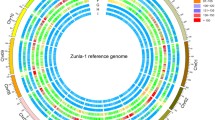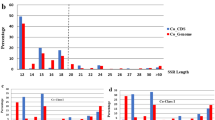Abstract
Microsatellites or Simple Sequence Repeats(SSRs) are informative molecular genetic markers in many crop species. SSRs are PCR-based, highly polymorphic, abundant, widely distributed throughout the genome and inherited in a co-dominant manner in most cases. Here we describe the presence of SSRs in cDNAs of cotton. Thirty one SSR primer pairs of 220 (∼14%) tested led to PCR amplification of discrete fragments using cotton leaf cDNA as template. Sequence analysis showed 25% of 24randomly selected cDNA clones amplified with different SSR primer pairs contained repeat motifs. We further showed that sequences from the SSR-containing cDNAs were conserved across G. barbadense and G. hirsutum, revealing the importance of the SSR markers for comparative mapping of transcribed genes. Data mining for plant SSR-ESTs from the publicly available databases identified SSRs motifs in many plant species,including cotton, in a range of 1.1 to4.8% of the submitted ESTs for a given species.
Similar content being viewed by others
References
Ayers, N.M., A.M. McClung, P.D. Larkin, H.F.J. Bligh, C.A. Jones & W.D. Park, 1997. Microsatellites and a single nucleotide polymorphism differentiate apparent amylose classes in an extended pedigree of US rice germplasm. Theor Appl Genet 94: 773–781.
Brubaker, C., A.H. Paterson & J.F. Wendel, 1999. Comparative genetic mapping of allotetraploid cotton and its diploid progenitors. Genome 42: 184–203.
Brubaker, C., R. Cantrell, M. Giband, B. Lyon & T. Wilkins, 2000. Letter to Journal of Cotton Science community. J Cotton Sci 4: 149–151.
Cardle, L., L. Ramsy, D. Milbourne, M. Macaulay, D. Marshall & R. Waugh, 2000. Computational and experimental characterization of physically clustered simple sequence repeats in plants. Genetics 156: 847–854.
Davierwala, A.P., W. Ramakrishna, P.K. Rajekar & V.S. Gupta, 2000. Sequence variation at a complex microsatellite locus in rice and its conservation in cereals. Theor Appl Genet 101: 1291–1298.
Diatchenko, L., Y.C. Lau, A.P. Campbell, A. Chenchik, F. Mooradam, B. Huang, S. Lukyanov, K. Lukyanov, N. Gurskaya, E.D. Sverdlov & P.D. Siebert, 1996. Suppression subtractive hybridization: A method for generating differentially regulated or time-specific cDNA probes and libraries. Proc Natl Acad Sci 93: 6025–6030.
Feng X., S. Saha & K.M. Soliman, 1997. DNA fingerprinting in cotton using AFLP. Focus 19: 11–12.
Galau, G.A. & T.A. Wilkins, 1989. Alloplasmic male sterility in AD allotetraploid Gossypium hirsutum upon replacement of its resident A cytoplasm with that of D species G. harknessii. Theor Appl Genet 78: 23–30.
Gur-Arie, R., C.J. Cohen, Y. Eitan, L. Shelef, E.M. Hallerman & Y. Kashi, 2000. Simple sequence repeats in Escherichia coli: Abundance, distribution, composition and polymorphism. Genome Res 10: 62–71.
Huntington's Disease Collaborative Research Group, 1993. A novel gene containing a trinucleotide repeat that is expanded and unstable on Huntington's Disease chromosomes. Cell 72: 971–983.
Jones, W.S., D. Cai, O.S. Weislow & B. Esmaeli-Azad, 1997. Generation of multiple mRNA fingerprints using fluorescencebased differential display and an automated DNA sequencer. Biotechniques 22: 536–543.
Kantety, R.V., M.L. Rota, D.E. Mathews & M.E. Sorrells, 2001. Data mining for simple sequence tags from barley, maize, rice and wheat. Plant Mol Biol (in press).
Karaca, M., 2001. Characterization of Cynodon spp. and Gossypium spp. Genomes using Molecular and Cytological Techniques. Ph.D. diss. Mississippi State Univ., Mississippi State, MS.
Katterman, F.H. & J.E. Endrizzi, 1973. Studies on the 70S ribosomal content of a plastid mutant in Gossypium hirsutum. Plant Physiol 51: 1138–1139.
Kohel, R.J., 1978. Linkage tests in Upland cotton. III. Crop Sci 18: 844–847.
Kohel, R.J. & C.R. Benedict, 1971. Description and CO2 metabolism of aberrant and normal chloroplasts in variegated cotton Gossypium hirsutum L. Crop Sci 11: 486–488.
Liang, P. & A.B. Pardee, 1992. Differential display of eukaryotic messenger RNA by means of the polymerase chain reaction. Science 257: 967–971.
Liu, S., S. Saha, D. Stelly, B. Burr & R.G. Cantrell, 2000a. Chromosomal assignment of microsatellite loci in cotton. J Heredity 91: 326–332.
Liu, S., R.G. Cantrell, J.C. McCarty, Jr. & J. McD Stewart, 2000b. Simple sequence repeat-based assessment of genetic diversity in cotton race stock accessions. Crop Sci 40: 1459–1469.
Paterson, A.H. & R.H. Smith, 1999. Future horizons: biotechnology for cotton improvement. In: C.W. Smith & J.T. Cothren (Eds.), Cotton, pp. 415-432. John Wiley & Sons, Inc., New York, NY.
Qureshi, S.N., M. Altaf-Khan, J.N. Jenkins, C.L. Brubaker, U.K. Reddy & S. Saha, 2001. A genetic linkage map of SSR markers based on Gossypium nelsonii and G. australae F2 population.
Plant and Animal Genome Meeting IX, Jan. 13-17. San Diego, California. Abst., pp. 219.
Ramsey, L., M. Macaulay, L. Cardle, M. Morgante, S. Ivanissevich, E. Maestri, W. Powell & R.Waugh, 1999. Intimate association of microsatellite repeats with retrotransposons and other dispersed repetitive elements in barley. Plant J 17: 415–425.
Reddy, O.U., A.E. Pepper, I. Abdurakmonov, S. Saha, J. Jenkins, T. Brook & M. El-Zik, 2001. New dinucleotide and trinucleotide microsatellite marker resources for cotton genome research. J Cotton Sci 5: 103–113.
Saghai-Maroof, M.A., R.M. Biyashev, R.M. Yang, G.P. Zhang & R.W. Allard, 1994. Extraordinarily polymorphic microsatellite DNA in barley: Species diversity, chromosomal locations & population dynamics. Proc Natl Acad Sci 91: 5446–5470.
Saha, S., M. Karaca, J.N. Jenkins & D. Lang, 2001. Improved methods for screening cotton cDNAs using flurochrome-labeled AFLP-and SSR-specific primers. In: J.N. Jenkins & S. Saha (Eds.), Genetic Improvement of Cotton: Emerging Technologies, pp. 239-255. Science Publishers, Inc., Enfield, NH.
Saha, S., H. Tan, M. Karaca & J.N. Jenkins, 1999. Gel based DNA marker technologies in cotton. ICAR 17: 8–11.
Song, P., E. Yamamoto & R.D. Allan, 1995. Improved procedure of differential display of transcripts from cotton tissue. Plant Mol Biol Rptr 13: 175–181.
Wren, D.J., E. Forgacs, J.W. Fondon III, A. Pertsemlidis, Y.S. Cheng, T. Gallardo, R.S. Williams, R.V. Shohet, J.D. Minna & H.R. Garner, 2000. Repeat polymorphisms within gene regions: phenotypic and evolutionary implications. Am J Hum Genet 67: 345–356.
Yu, K., S.J. Park & V. Poysa, 1999. Abundance and variation of microsatellite DNA sequences in beans (Phaseolus and Vigna). Genome 42: 27–34.
Author information
Authors and Affiliations
Rights and permissions
About this article
Cite this article
Saha, S., Karaca, M., Jenkins, J.N. et al. Simple sequence repeats as useful resources to study transcribed genes of cotton. Euphytica 130, 355–364 (2003). https://doi.org/10.1023/A:1023077209170
Issue Date:
DOI: https://doi.org/10.1023/A:1023077209170




